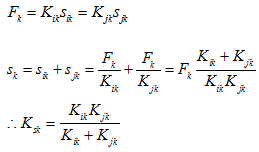Mount Stiffness |

|

|

|

|
|
Mount Stiffness |

|

|

|

|
The bodies connected by the bushing are flexible and may deflect under the load being transmitted. This phenomenon is modeled with the Mount Stiffness feature. Mount stiffness models the structural stiffness of the bodies, thus mounting the bushing as a linear spring and damper in series with the bushing in each direction.
The mount or structure surrounding a bushing deflects under the force transmitted by the bushing. The local stiffness models this deflection. If the I-Body and J-Body connected by the bushing are modeled as rigid-bodies, then you must estimate structural deflection separately and add that value to the bushing-rubber deflection. Mount stiffness is NOT required if the two bodies are modeled as flexible bodies.
To include local structural stiffness in the bushing model, you enter the combined local stiffness of the I-Body and J-Body, and then set the local stiffness flag to active.
When one or both bodies is flexible, you specify that the mount stiffness is conditionally active only when the I-Body and J-Body are both rigid.
Let:
dk |
be the bushing deformation in the kth direction. |
sk |
be the net local structural deflection in the kth direction. |
sik |
be the local structural deflection of the I-body in the kth direction. |
sjk |
be the local structural deflection of the J-body in the kth direction. |
Ksk |
be the local structural stiffness in the kth direction. |
Kik |
be the local structural stiffness of the I-Body in the kth direction. |
Kjk |
be the local structural stiffness of the J-Body in the kth direction. |
Csk |
be the local structural damping in the kth direction. |
Cik |
be the local structural damping I-Body in the kth direction. |
Cjk |
be the local structural damping of the J-Body in the kth direction. |
Fk |
be the bushing force in the kth direction. |
Then the net structural deflection for the kth direction is:
![]()
Since the I-body structural stiffness, the J-body structural stiffness and the bushing act in series, the forces in kth direction in the bushing, the I-body and J-body are all equal.
Therefore:

Through similar logic, one can conclude:

The structure and the bushing act in series. Therefore they must generate the same force:

The above equation is integrated to yield Sk, where the structural deformation is known and accounted for.